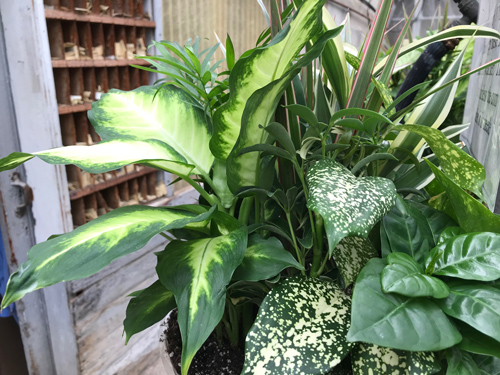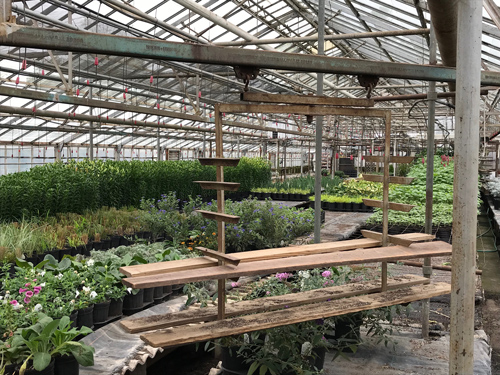Story and photos by Michelle Sutton
Mischler’s opened in 1944, making this year the
75th anniversary of this western NY institution.
History & Horticultural Chops
When I listened back to my interview with Mischler’s VP, co-owner, and head grower Mark Yadon, I heard myself saying, “That’s cool!” an embarrassing number of times. The gushing couldn’t be helped because Yadon was showing me so many undeniably cool things at Mischler’s Florist & Greenhouses in Williamsville.
Case in point: Mischler’s existing Integrated Pest Management (IPM) program, begun in 1989 by David Mischler, has benefitted from Yadon’s four decades of IPM and biocontrol experience. The growing operation now controls the majority of problem insects with beneficial ones, rather than with spraying. For instance, for five years now, Yadon has grown Mischler’s poinsettias pesticide-free—and is on track toward the goal of zero spraying for all of the greenhouse crops.


Yadon is a member of the Cornell Project Work Team for Horticulture, a group of experienced growers that travels around NY to advise growers newer to the industry. Dr. Betsy Lamb, who coordinates Cornell’s Ornamentals IPM program, uses Yadon as a mentor to other growers and Mischler’s as a place where folks can come learn how to do effective biocontrol. In 2008 Mischler’s was recognized with an “Excellence in IPM” award from Cornell.

“It’s something I’m really proud of—developing this biocontrol program and then advising others,” he says. “In my work history of growing roses, for example, there was a lot of spraying involved. I’m really happy that I don’t have to do that anymore—now, I joke that all I have to do is sprinkle bugs around.”
Yadon set out on his plantsman’s path with a botany degree in 1978 from Oregon State University. After college, he became an IPM consultant in Washington State, monitoring apple orchards for insects and diseases to help him make spraying recommendations. When he was ready for a new challenge, he moved to Eugene, Oregon and became involved with the greenhouse industry, growing fresh cut roses, eventually managing production at a 10-acre facility. He went on to manage large rose and cut flower operations in San Diego, South Carolina, New Jersey, and New Hampshire.
The opportunity to become VP/co-owner with a path to sole ownership at Mischler’s came up in 2002. “I loved the smaller scale of the operation and the possibility of settling in once place. My wife, Sang Hui, and I like Buffalo very much—including the horticultural hotspot it’s become.”
Evolution of Offerings
Frank Mischler Sr. opened a full-service floral shop in 1944 in a suburban neighborhood on South Forest Road in Williamsville. In time, it transferred to his sons, Frank Jr. and David (Dave) Mischler. Frank Jr., 66, is still the president of the company and manages the floral shop and delivery. Dave, 82, is semi-retired but still a part of the mix. Maggie Wittmer, ageless, is the head floral designer and has worked with Mischler’s for nearly 32 years.
In the 1940s, everything was grown in “digger flats,” open flats of annuals that you would have to dig plants from and put in a newspaper “cone” to give to the customer. Frank Mischler thought the digger method was too labor-intensive and messy; he moved to growing plants in terra cotta pots. In addition to florist services, the business specialized in growing annuals for, and planting, cemetery pots; they serviced eight cemeteries in western NY. Frank Mischler alone would spend a week of long days getting cemetery urns planted in time for Decoration Day (now Memorial Day).


Over time, the cemetery services receded, but the floral shop continued to thrive, and new services were added. The majority of the greenhouse space was used for in-ground growing of cut flowers to support the florist business until plastic packs and pots became available around 1960. Then it became possible to produce much larger quantities of annuals. In 1985, the business acquired an automatic seeder, which is still in use for spring sowing.
“We don’t grow annuals in flats anymore; instead, we focus mostly on 4.5-inch pots of specialty annuals,” Yadon says. Within that category, one of Mischler’s signatures is frost-tolerant annuals. “We have a stepwise process for hardening off such annuals, like snapdragons, nemesia, diascia, osteospermum daisies, annual phlox, calibrachoa and petunias, so that they can be planted in early to mid-April,” he says. “They bloom early, go all season, and then resist frost in the fall. Planting frost-tolerant annuals in April is a great value for our customers.”
An even bigger Mischler’s signature is its 59¢ perennial sale, held every year for a week (or until plants are gone) in the third or fourth week of April. The perennials are grown from seed in the greenhouses and sold in packs of four. “It’s a huge event for us,” Yadon says. “We seed about 4000 flats, and each flat has 48 plants.” Customers can typically get the plant list just after Valentine’s Day; the list includes information about deer resistance, bloom length, sun/shade/drought tolerance, and appeal to butterflies and hummingbirds.
This will be the 20th year of the popular sale. “It’s an inexpensive way to do mass plantings for curb appeal or to try new plants,” Yadon says. “Most of the perennials bloom the same year, so the impact is immediate. Commercial landscapers and homeowners both love it and come back year after year.”
As with the frost-tolerant annuals, Yadon carefully hardens the baby perennials off before the sale, and then encourages customers to get them in the ground right away. “I recommend they monitor the newly planted perennials closely for moisture for the first couple of weeks, and then they are on their own,” he says. “I get feedback all the time about how fast these plants take off, and how much people appreciate being able to build a garden over time on limited incomes.”
Each year, Yadon adds new perennials to the mix; this year, he’s going to add more native plants to the 59¢ perennial sale. “A lot of the perennials currently on the list are native, but they haven’t been grouped together or promoted as such,” he says. “Customers have been asking for more native material, and we are happy to move in that direction. For instance, Rudbeckia ‘Goldsturm’ and ‘Indian Summer’ are always on the list—and they’re very popular—but this year I’ll also add a straight-species of a black-eyed Susan native to our larger ecosystem.”



Quest for Curb Appeal
Rudbeckia ‘Indian Summer’ is a quintessential plant for curb appeal, according to Yadon. “It blooms from the first season and earlier and longer than other black-eyed Susans,” he says. “The delphiniums are also fantastic for curb appeal beginning in July. But in terms of folks who are selling their home and want to make a statement, we recommend bright showy annuals like the SunPatiens series of New Guinea impatiens. They can tolerate quite a bit of sun or even full sun, they grow a nice deep root system, and they really pop with color.”
Another way to create curb appeal is to feature mixed containers in visually key places. Yadon and the staff recommend to customers that they “stay in season” to get the best results. This means using pansies and other frost-tolerant annuals in spring; when they get leggy or beaten up, switching those out and putting in showy summer annuals; then in fall, replacing the summer annuals with mums and ornamental kale. Mischler’s applies this technique to the container planting that they do for customers and for the 55 large (35” diameter) containers they design and plant for Williamsville’s Main Street each year. “Customers will often come in and ask what the plants on Main Street are—sometimes they even bring a piece of a plant with them,” Yadon says.
In terms of new plants, Yadon says that studying what’s trendy is just the first step. “We have the approach that we set the trends,” he says. “The staff and I discuss what we like and then put displays together to expose customers to new plants, new ways of using plants, and/or new plant combinations.” Trends ebb and flow; however, Yadon finds that miniature plants and succulents are still very popular, as are hardy perennials used in container gardens.![]()
Get Social with Mischler’s Florist & Greenhouses
Twitter: @Mischlers
Facebook: MischlersFlorist
Instagram: #mischlersfloristI
Michelle Sutton (michellejudysutton.com) is a horticulturist, writer, and editor living in New Paltz, NY.
Views: 1





